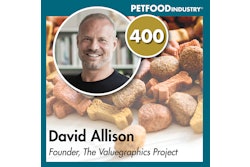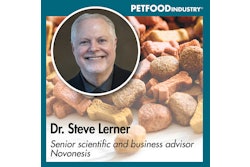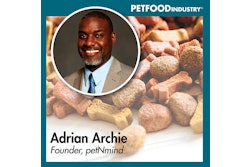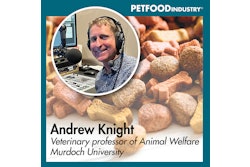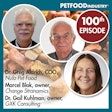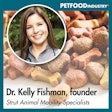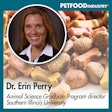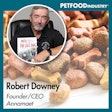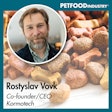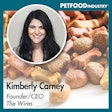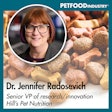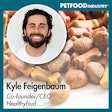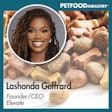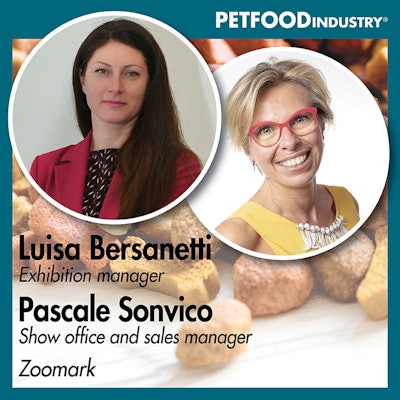
In Episode 77 of Trending: Pet Food, host Lindsay Beaton is joined by Zoomark Exhibition Manager Luisa Bersanetti and Show Office and Sales Manager Pascale Sonvico to delve into the key takeaways from the European pet food market in 2024 and what lies ahead in 2025. The discussion highlights emerging trends, challenges, and opportunities shaping the industry, offering valuable insights for professionals navigating this dynamic market.
The below transcript is from Episode 77 of the Trending: Pet Food podcast. Host Lindsay Beaton sits down with Zoomark Exhibition Manager Luisa Bersanetti and Show Office and Sales Manager Pascale Sonvico to look at how 2024 finished and where 2025 is headed for the European pet food markets. You can find the episode at Trending: Pet Food, on SoundCloud or on your favorite podcast platform. This episode originally aired on December 19, 2024.
We want to thank Coperion for sponsoring this podcast. For over 50 years, Coperion has supplied the most recognized pet food brands throughout the world with state-of-the-art dry bulk material handling systems.
Lindsay Beaton – editor, Petfood Industry magazine, and host, Trending: Pet Food podcast: Hello, and welcome to Trending: Pet Food, the industry podcast where we cover all the latest hot topics and trends in pet food. I’m your host and editor of Petfood Industry magazine Lindsay Beaton, and I’m here today with Luisa Bersanetti, exhibition manager, and Pascale Sonvico, show office and sales manager, at Zoomark. Hi guys, and welcome!
Pascale Sonvico, show office and sales manager, and Luisa Bersanetti, exhibition manager, both with Zoomark: Hi!
Beaton: In case you’re unfamiliar with my guests or Zoomark, here’s what you need to know.
With over 14 years of experience in international exhibitions, sales, marketing and management, Luisa coordinates the leading pet exhibitions in Italy: QuattrozampeinFiera, a series of B2C shows, and Zoomark, an international B2B trade show for pet food and pet care in BolognaFiere, Italy. Her professional experience in Europe, China and the U.S. strongly improved her skills in project management and business development. She is currently responsible for managing the show, and she coordinates the whole Zoomark team. Under her guidance, the show achieved record numbers in 2023.
With over 30 years of experience at Zoomark, Pascale coordinates the show office team and the international sales agents' network. She also develops special projects designed to enrich the show experience as well as marketing and promotional activities in synergy with other trade shows around the globe to support the international pet supplies industry.
Luisa and Pascale have extensive expertise in monitoring and analyzing the European pet market segments, as well as connections among all those segments, which is why I’ve brought them on today to answer this question: How have the European pet food markets done in 2024, and what’s ahead for 2025?
I want to start and spend the bulk of our time talking about 2024 because it has mostly already happened, and we're starting to wrap up the year. How has the European market fared this year?
Sonvico: The pandemic, of course, made the pet population boom because people that were stuck at home needed to have a companion, so they decided to adopt more pets. This made, of course, the pet population grow in Europe. It is estimated that currently we have 160 million households that own at least one pet, mostly dogs and cats. This is to say that some 50% of the total households in Europe have a pet.
According to FEDIAF, which is the trade association that represents the European industry of pet food, there are some 350 million pets in Europe, not considering the aquarium fish, and these pets consumed food for €29 billion (US$30 billion) in 2022.
In Italy, half of the households have at least one pet. We estimated that there are 10.2 million cats and 8.8 million dogs in Italy. But we also have ornamental birds, which are estimated in 13 million small mammals and other pets, which are around 3.5 million. In 2023, Italy recorded pet food sales for dogs and cats of over €3 billion, with a growth rate of 10% for dog food and 15% for cat food year on year.
More generally, all the European pet food market has remained strong in 2024, and the industry has shown to be resilient despite the external challenges such as the inflation or the supply chain disruptions.
Premiumization is, of course, an ongoing trend, and it is quite a strong driving factor in Italy and in Europe and the consumers are prioritizing health and wellness products for their pets who are treated as real family members. This has led to increase the spending on premium pet products, on wellness items and healthcare, for instance.
According to Euro monitor, premium pet food saw substantial growth as owners increasingly opt for high quality, nutrient rich products. Still considering the current inflationary pressures, pet owners now tend to be more selective and look for a more convenient value for money. This doesn't necessarily mean that they are trading down or turning to lower quality products for their pets, since they still believe that their pets deserve the best, but they are more price conscious.
Of course, the industry is called to meet this strong demand and develop new solutions that combine premium quality with more affordable prices, because this is what many companies are already doing by developing new recipes, sourcing new ingredients, optimizing the manufacturing processes and also dosing differently their products.
Another driving factor is health and wellness consciousness. The pet owners are increasingly focused on their pet’s health, with a growing demand for vitamins, for instance, or for supplements and specialized healthcare products, for instance. Around the 32% of the Italian pet owners purchase supplements, and large majority consult the veterinarians for having a diet or health advice.
What is evident is also the focus on sustainability and natural products, which has intensified in recent years, ecofriendly and natural pet products are gaining traction, and pet owners are looking for environmentally conscious brands. They are demanding for more ecofriendly packaging and responsibly sourced ingredients. This trend is particularly strong in Western Europe, where markets like Germany, France and Italy have responded by increasing the availability of sustainable and organic production and options.
According to a recent survey we carried out with the research institute Nomisma on pet owners, 46% of the Italian pet owners are willing to spend a little bit more on sustainable products, and this reflects also broader and shift toward eco-conscious purchasing choices.
Another driving factor in this year's market is e-commerce, which continues to play a critical role, expanding rapidly as pet owners increasingly look for convenience and a wider range of products to choose from. Online specialized platforms like Zooplus, for instance, now account for a significant portion of pet food sales across Europe, especially for big packs, and the sector is expected to still grow in the next years maintaining the same upward trend that it has registered in the recent years.
Beaton: You gave several interesting data points there that I want to expand on a little bit more. When you were talking about pet ownership, it sounds like there are more cats than dogs, and that smaller animals, like ornamental birds, are a pretty significant portion of the overall pet landscape.
One of the things that's been happening here in the U.S. in 2024 is that cats are finally getting their due. The industry is focusing a little bit more on formulations for cats. Cat ownership is rising. It still hasn't reached dog ownership, but it's increasing, and part of the reason for that is because people in the U.S. are more mobile right now. They have less space. Cats are easier to care for. These smaller animals can live in smaller spaces, whereas, with a dog, and particularly big dogs that we have here, you need a yard, you must walk them, you need pet sitters, all kinds of stuff.
Is there a similar phenomenon in Europe where smaller animals are just more practical? Is it a cultural thing do you think? Or does it just make sense to have smaller animals in Europe?
Bersanetti: Well, exactly yes. It is the same sort of attitude we have in Italy and in Europe. Cats are more independent. They are easier to keep. You must consider that in Europe, our houses are much smaller than the ones in the U.S., and most of the population does not have a garden or a yard, so it is difficult to have a dog and to keep it in a small home.
Urbanization is also very strong in Europe. Most of the people are living in towns or cities, and they have smaller apartments.
Sonvico: Dogs were much more popular, especially medium-sized and large-sized dogs, in the past because many people were still living in the countryside or in farms. Dogs were used also as guards. Now, dogs are just considered companions, so they must be suitable to our modern lifestyle.
Italians and Europeans normally adopt dogs, small dogs or medium-sized dogs. There are not many large-sized dogs, and small other pets are quite common for this reason, because they are easy to keep.
Beaton: A lot of the trends you mentioned focus on health and wellness, which makes sense, because globally, that is a growing trend. One of the things we've been talking about a lot and covered a lot in 2024 is the functionality of formulations and treats and supplements. Are there any particular functional claims that are drawing European pet owners right now? Or is it more of, “I want something that is going to increase the overall health and wellness, the overall longevity of my pet”?
Sonvico: I believe the concern of the pet owner is always to grant the health of their pets and to keep them healthy and grant their longevity, and so they look for products that are perfectly formulated to keep them healthy and happy for a long life. Also. in this case, the pandemic changed our point of view in some way, because we became more conscious about our own health, and this consciousness is reflected also in our relationship with our pets, which are considered family members.
We wish to make sure that they have a happy and healthy life, so we tend to choose products that are totally natural, that respect the nature of the pets and the nutritional demands that the pets have. In some cases, we see that the trend of humanization that we had in the past, when the pet owners tended to feed their pets a lot of snacks and treats without thinking about how that would impact in their health, now is changing. This approach is changing because of this health consciousness, and now pet owners are trying to find the good solutions that respect the nutritional demands of vets more than in the past.
Beaton: One of the other hot points you touched on is e-commerce. It's very much an omnichannel space these days. Consumers really are going for that combination of wanting to find top nutrition but also convenience.
COVID absolutely spun that trend forward in a big way, because a lot of people couldn't leave their homes, or didn't want to leave their homes, but still had to feed their pets.
What does the e-commerce space look like in Europe? Because in North America, we have several large e-commerce platforms, and retailers will have their own e-commerce platforms. What is the mix there in terms of large e-commerce platforms versus retailers doing their own thing?
Sonvico: As you said, the pandemic has also promoted the e-commerce platforms in some way. In Europe, you are not very used to use the e-commerce platforms, as you are probably in the U.S. Of course, during the pandemic, that was the main source of our purchases, and so we started to use e-commerce platforms very frequently in that period, and we still do.
I must say that in some cases, especially when it comes to pet health, the pet owners went back to the brick-and-mortar shops when it became possible, because pet shops are still the main advice for the pet owners, especially when we must buy something for the health of our pets.
Still, there are some specialized e-commerce platforms that are developing and growing a lot in this period. One of those is Zooplus, which is an international, European platform which is growing. It is used basically because it gives you a great variety of possibilities to choose from, of course, and it is more convenient.
You can also have some subscription-based programs, which is also very convenient for the pet owners. As you said, there are also some companies that have developed their own platforms, their own e-commerce platforms, and specialized the stores that now sell both in their shops and through the web.
There are also some specific models of D2C business that are developing in Europe. That means that companies, manufacturers, can sell their products directly to the end consumers, to the pet owners, and they offer very specific and customized solutions for the pet owners.
Beaton: Before we move on to talking about 2025m because I want to see what's going to be going on in Europe next year, are there any particularly interesting trends driving the pet market in Italy specifically?
Bersanetti: Italy is following the European trends. Humanization is the key driver to all decisions by the customer. Premiumization, super-premium pet food, is what our customers are looking at, especially the youngest generation, which are very attentive to feeding their pets properly and looking for eco-friendly solutions. They are very attentive to the environment, super-premium products, and eco-friendly products and packaging is what they're really caring for.
I would say also the nutrition, the healthier approach to nutrition, is very strong in Italy. The organic pet food, functional food is what is highly requested. People are looking for free from artificial additives, food rich in beneficial nutrients, for instance, but also plant-based food or new protein sources like insect flour. Basically, humanization, premiumization and sustainability is what we are now seeing in Italy.
Beaton: You mentioned insect protein. Europe is well ahead of North America when it comes to regulatory permissions for insects in food. I know when I attended Zoomark in 2023, in the new products, there were several insect options. Walking around, it's much more normalized than it is at the shows that I attend here in the States. Are you seeing that as a growing segment in Europe? Is it continuing to gain traction as more research comes out? Is there any pushback from consumers at all? Or do you think it'll just continue to get bigger for now?
Bersanetti: No, I think it will continue. It's a trend that will slowly continue. The research on new ingredients, new formulations, more natural formulations, is something that the Italian customer is really looking for. The research and the offer for such products is definitely continuing to grow.
Beaton: I want to shift focus now to 2025. As you are starting to register exhibitors, register attendees for Zoomark, the next show taking place in 2025, what are you hearing or what do you believe the industry is most concerned about heading into the new year? What do you think the show floor is going to look like? What is the focus going to be on?
Sonvico: If we look ahead to 2025, we expect to see continued growth in premium and functional pet foods, and possibly with an improved value for money ratio, as we said before, because the pet owners are increasingly prioritizing their pets well-being, leading to a greater demand for natural, organic and specialized pet food that address also specific health needs, such as food designed for digestive health, for weight or allergy management or for joint support.
Humanization will continue to drive this trend, because the owners seek to provide their animals with the same level of care and nutrition that they themselves enjoy. As we already mentioned before, the question is to provide the pet owners with new formulas and brands that combine good quality and affordable prices. That's why the industry is now trying to develop new formulas and source new ingredients, such as insect flour, to find new solutions to present to the market.
Sustainability, of course, will still be a key driver. More consumers are gravitating towards eco-friendly products, like those with sustainable packaging and ethically sourced ingredients. Companies that invest in sustainable practices will likely gain a competitive edge, particularly as younger consumers become a dominant force in the market. Companies that not only reduce their carbon footprint but also prioritize ethical practices and actively contribute to environmental and social causes will gain a competitive edge. Failure to adopt ethical practices could result in reputational damage, because the consumers are increasingly scrutinizing brands for their social impact.
Of course, technology will also be a key trend in the future, as it will be integrated more and more often in healthcare. Technology-driven products, like personalized nutrition or health tracking, will develop in the future. Companies will likely invest in data-driven solutions with the aim to create customized feeding plans based on pet-specific health needs. This will combine the pet food science with the veterinary care.
Private labels will also be very important in the future. They are developing a lot, and this is a trend that we will have to watch. In response to inflation, many consumers are turning to private label products, which offer good quality at more affordable prices, especially in the mid-priced economic segment.
According to the U.S. market research institute, Circana, in 2023, private labels acquired nearly a third of the overall pet food value share in Europe, with France, Italy, Germany, Spain, the UK and the Netherlands as the main countries where private label is developing.
According to Circana, private labels are expected to continue growing their share in the market. This will develop especially in modern retail -- the supermarket, hypermarkets and discount stores -- but also in the specialized chain stores, where they account for an increasingly large portion of the sales. This is because the specialized chain stores are trying to find their own identity, and they understand that private label gives them a good chance as it attracts more customers, especially in this specific period where there is a lot of economic uncertainty and inflation rate is quite high.
Bersanetti: I would add that the market is somehow reflecting what we see in our show at Zoomark. Our show has grown since pandemic, and this is reflecting the growth of the market and the resilience of it. Many new companies are popping up, bringing innovation and technology as Pascale said.
This is a sign of the time. This is a very positive data for me, because it shows the good health of this market. We also see it in new companies from the supply chain. For instance, there are packaging companies that are now opening production lines or switching production lines to pet food, because it's something the market is looking for.
Beaton: What do you guys think the biggest challenge will be for companies working in the European pet food space in 2025?
Bersanetti: I think the biggest challenges would be some of the issues that we've had so far. The disruption on the supply chain due to the geopolitical situation, which is not going to find a resolution in the short future. This is continuing to have a rising cost of raw materials and packaging. This can also be seen the other way around, with new opportunities for those companies that offer sustainable products. As we mentioned before, sustainability is really one of the key drivers in Europe, and those companies that can cope with sustainability will have a competitive advantage.
Sonvico: In Europe, sustainability is a big issue. The European Union has recently introduced very strict regulations regarding ingredients labeling and sustainability in general. New regulations will soon come for packaging. For the industry, it is necessary to adapt to industrial processes to the new rules. Many investments are required because, while it is necessary to ensure product safety and sustainability, the regulations have added pressure on manufacturers to comply with maintaining profitability.
They must face new challenges, and this will be, of course, more difficult for smaller players on the market. If the companies, if the industry, can face the new demands of the European market, they will have big chance for growth, because sustainability is really something that the pet owners or the consumers in general, in Italy and in Europe care for. They look for products that reflect this consciousness.
Beaton: What do you think is the most difficult part of sustainability right now? Because obviously it touches every part of pet food, from ingredients to transportation to packaging. Which segment has the biggest challenges ahead of them, especially with the new regulations that are coming into play? Sonvico: Sustainability is a very big theme that involves everything. The industry is really called to do something, because the industry has to change all the processes to be more eco-friendly and environmentally sustainable. From the manufacturing processes to logistics, of course, everything is involved. What is also fundamental, I think, is communication, because a company needs to communicate the actions, the initiatives they are doing to comply with the new requirements in terms of sustainability.
Communicating sustainability is very difficult, because there's another big issue in Europe, which is greenwashing. Many companies tend to misuse communication when it comes to sustainability, and they claim being sustainable without any specific action, without any specific involvement and engagement in sustainability. One of the regulations that are being implemented in this period in the EU regards communication and greenwashing, which is very, very important.
Beaton: As we wrap up our conversation, I want to ask how you guys feel about the European pet market going into 2025. Are you feeling optimistic? Do you think there are a lot of challenges ahead? What do you think we're going to see coming into the new year? And how do you feel overall about the market?
Bersanetti: My opinion, the market is solid, and in the next year, it will give us good results. I would say Europe has a long history of pet ownership, and even though, after COVID, there's the plague of pet abundance has increased because of pet adoption has boomed. Still, Europeans have lot of care and devotion to their pets. What I see is that with all the kittens that have been adopted during COVID, they are now growing up and they will soon get old.
In fact, veterinary expenses are increasing, and veterinary care is a point that be crucial in the future.
There is a lot of discussion, especially in Italy, about the veterinary services and pet care products. For instance, the Italian government has introduced specific subsidies for veterinary expenses to support veterinary care to senior population. There is also a new decree that will allow the sale of OTC medicines to pet shops, groceries and superstores. This is bringing a change and the possibility of development and a shift toward professional pet care in Italy. I think, and what we see is that in Europe, this sector will have a good increase.
Sonvico: If you wish to know something more about the market, about Italian market and the European market. Of course, Zoomark will be the place to be on May 5-7 next year in Bologna, Zoomark will be the leading trade show in Europe. We will welcome more than 1,300 exhibitors coming from all parts of the world, and some 30,000 buyers from the large importing companies to the small Italian pet shops. All the pet businesspeople will gather in Bologna on May 5-7 next year.
In our show, we will have a specific hall dedicated to the supply chain, where we will welcome the companies that supply products, ingredients, raw materials, machineries and packaging solutions for the industry. Besides the show, there's also the possibility to take part in seminars, conferences and networking activities that will develop during the three show days, starting in January, registrations will be open. Our website is zoommark.it. where you can find information and data regarding our next show and the result of past one.
Beaton: Thank you both so much for coming on today. As we wrap up the year, it’s important to see how the industry has done globally as well as what we should be on the lookout for in the coming year, so I’m thankful you were able to come on and share your knowledge!
Both: Thank you, Lindsay. Thanks for having us on.
Beaton: That's it for this episode of Trending: Pet Food. You can find us on petfoodindustry.com, SoundCloud or your favorite podcast platform. You can also follow us on Instagram @trendingpetfoodpodcast. And if you want to chat or have any feedback, I'd love to hear from you. Feel free to drop me an email: [email protected].
Of course, thanks again to our sponsor, Coperion. For over 50 years, this company has supplied the most recognized pet food brands throughout the world with state-of-the-art dry bulk material handling systems.
Once again, I'm Lindsay Beaton, your host and editor of Petfood Industry magazine, and we'll talk to you next time. Thanks for tuning in!


